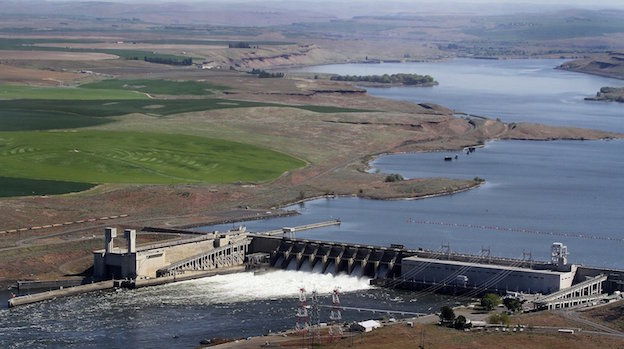forum
library
tutorial
contact

Corps, Washington Study Impacts on
Transportation, Recreation Without LSRDs
by K.C. Mehaffey
NW Fishletter, December 11, 2024
|
the film forum library tutorial contact |

|
Corps, Washington Study Impacts on
by K.C. Mehaffey
|
A preliminary model that can be used to reflect needs for shipping grain,
fertilizer and wood products by way of barges, railroads or highways.
 The U.S. Army Corps of Engineers entered into agreements with the State of Washington to study impacts to transportation and recreational opportunities if the four lower Snake River dams are breached.
The U.S. Army Corps of Engineers entered into agreements with the State of Washington to study impacts to transportation and recreational opportunities if the four lower Snake River dams are breached.
Lt. Col. Katie Werback, commander of the Corps' Walla Walla District, signed separate agreements with the Washington State Department of Transportation and Washington's Recreation and Conservation Office to collaborate on the studies.
"Although these studies are purely exploratory and not linked to any immediate federal decision on dam breaching, they are essential for evaluating potential impacts and ensuring the Pacific Northwest is fully prepared for a range of future scenarios," Werback said in a Nov. 4 news release.
WSDOT's $4 million study on transportation impacts in the state is already underway. In October, the agency submitted a report to the Washington Legislature outlining its progress.
"While there have been several studies that address the topic of removing the dams, there is limited understanding of how transportation would be affected," WSDOT says on its website.
The Legislature appropriated the funds in its 2024 supplemental transportation budget, directing the agency to study highway, local road, and freight rail transportation needs if the dams are removed. "The study is evaluating scenarios for changes in infrastructure and operations that will be necessary to address the redistribution of shipments via barges to alternate modes such as road and rail. The assessment includes quantitative analysis based on available data in terms of both financial and carbon emission costs," the report says.
The Corps will expand the study area to Idaho and Oregon at a cost of roughly $750,000.
So far, a consulting team has analyzed the current use of barges, trains and trucks to move goods in the area that would be affected by removing the dams, and is scheduled to complete a report on the current conditions in December.
It has also created a preliminary model that can be used to reflect needs for shipping grain, fertilizer and wood products by way of barges, railroads or highways. The consulting team and DOE are reviewing the model to determine if additional adjustments are needed before it is used to project future shipping needs.
The study has included the collection of freight data from industry stakeholders. A technical advisory committee and a community advisory committee have been created and will continue to meet throughout the study period.
This winter, WSDOT expects to estimate the geological, geographical, rail, road and utility impacts in the transportation sector that would result from removing the dams, along with a safety analysis. In the spring, it will identify potential options for shipping goods if the dams are removed and estimate the competitive impacts to shippers currently using barge transportation.
A final report is expected in late 2026.
The study on impacts to recreation if the dams are removed is expected to cost $1.2 million and be complete by 2026. It will identify the loss of existing recreational opportunities and necessary investments for future recreational opportunities if Congress authorizes breaching the dams.
"Recreation is a big part of Washington State's culture and identity," Megan Duffy, director of the state's Recreation and Conservation Office, said in the news release. "Not only does outdoor recreation improve the mental and physical health of our residents, but more than $26 billion is spent on recreation trips and equipment annually, supporting 264,000 jobs across Washington State. It's important that we examine the potential impact to recreation in a scenario where the lower Snake River dams are breached."
Removing the dams would result in drawing down reservoirs and require investments to improve or create future recreational opportunities.
Other studies analyzing the impacts of removing the four lower Snake River dams are also underway.
In June, the federal Bureau of Reclamation and the Washington State Department of Ecology teamed up to analyze a range of alternatives for replacing water supply that irrigators, municipalities and industrial users would need if the dams are breached.
And in September, the U.S. Department of Energy launched a study on the regional energy infrastructure that would be needed to meet future energy demand if the dams are removed.
With respect to the Corps' participation in the studies, it is "important to recognize that these studies do not involve any implementation activities by the Corps of Engineers, but they do bring together experts from the Corps and our partners to provide data that can be critical to inform decision makers," Tim Fleeger, the Corps' Columbia River Basin policy and environmental coordinator, said in the agency's news release. "Only Congress can authorize breach of these dams."
learn more on topics covered in the film
see the video
read the script
learn the songs
discussion forum
